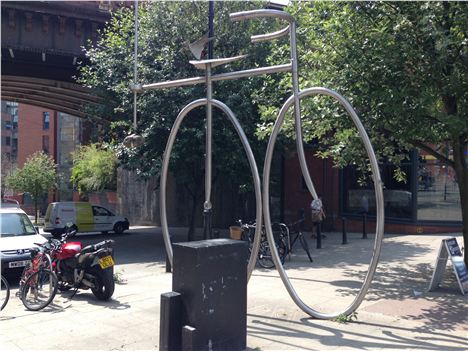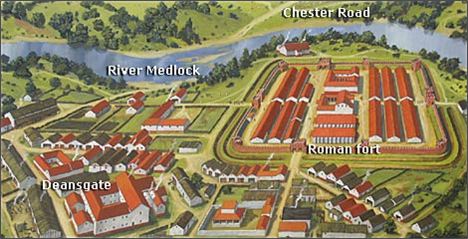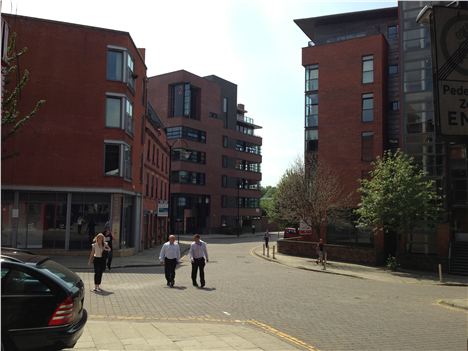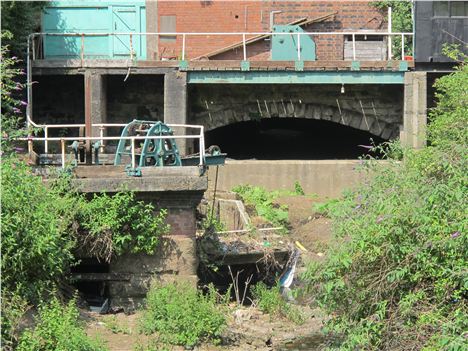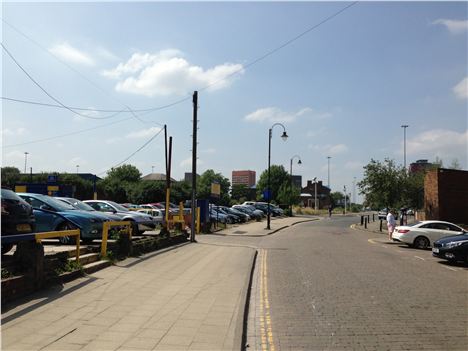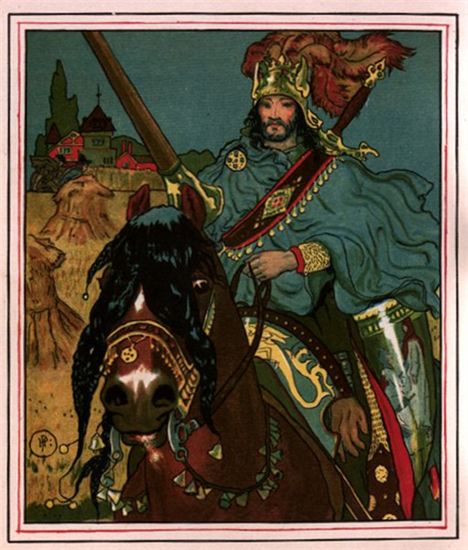Category: Good (in terms of history)
What?
Knott Mill Bridge, the bridge over the River Medlock on Deansgate.
Not sure where that is.
Don’t blame you. It’s that bit of old Deansgate that breaks off between Atlas bar and Deansgate train station, the bit behind that daft bike sculpture from George Wyllie. This was the original route out of Manchester to the south west. It’s as old as you can get in the city.
Big daft bike sculpture
What does that mean?
It's the first road around here. The original Roman road through Manchester, with Chester to the south west and Ribchester to the North. The road moves in straight sections often several miles in length, but has to break from the mathematical logic of moving quickly from A to B when it hits geographical impediments. Here the road had to dip east to cross the River Medlock via a ford. There was probably a sandstone outcrop over the Medlock in the way of the direct line. In the picture above the ford is left, top, centre.
Roman Manchester with ford over the Medlock although the Medlock has been made far too wide
It was on a ‘breast shaped hill’ west of here that the Romans built their fort around AD 79 - the Roman name for Manchester Mamucium reflects this name. The line of the fort wall can be picked out in white protruding from the nineteenth century mill pictured below. That feature was added when the 1870s’ building, Eastgate, was refurbished in the 1990s.
The old Roman route today
When was the bridge built?
Not sure. The records appear lost. The present stonework is most probably eighteenth century. Certainly in the Laurent and Green maps of the 1790s there’s a bridge featured. There must have been one before this, possibly several centuries before.
I reckon the stonework peeping out here (see picture below) is that of an eighteenth century version. It was a very important route, the old Packhorse pub, now offices on the north side, underlines the significance.
By the way this southern part of Deansgate from Peter Street to the River Medlock until the mid-nineteenth century used to be called Aldport Street or Lane. This meant 'old gate lane' and referred again to the fact that this was the original road into Manchester from the south.
There was a problem with Knott Mill Bridge though.
Hint of an ancient bridge
Too small?
Spot on. Plus the awkward gradient down to the narrow crossing became a source of gee-gee traffic congestion. That’s why the present continuation of Deansgate to Chester Road was built in 1841, the Bridgewater Viaduct, a broad and handsome structure of sandstone with a magnificent parapet. This is still used by thousands everyday. By 1841 this part of the River Medlock had changed more in the previous eighty years than it had since the Ice Age.
In what way?
The Bridgewater Canal had arrived in the 1760s. It threw a dark blanket over the Medlock. James Brindley placed the tamed river in an overflow tunnel under his canal. This meant he had water to maintain the canal level, he could divert water underground if there was danger of flooding and he could use water falling between the canal and the tunnel to turn waterwheels to lift and lower goods from Deansgate to the canal at Grocers Warehouse. Brilliant solution. Look at the picture of the Knott Mill Bridge carefully (the 'Hint of an ancient bridge' picture above) and you can see the machinery that operated the sluices which made all this possible. The picture is taken from Commercial Street, in a gap between buildings leading to the river. This is where Ian Simpson Architects is based.
Anything else?
Two things. Maybe three. Over the bridge, on the east, the car park plot was once the vast Knott Mill Ironworks. This was owned by the Galloway family, bridge builders, train builders, ship builders, boiler makers, steelworkers. It was one of the great engineering concerns of the nineteenth century and pioneered several developments in metallurgy. Wikipedia has a very good page on them. Another famous business in the area was the Globe Mattress Mill.
And.....
From the river via the ironworks site and up towards the roundabout on Chester Road was the Roman cemetery of Mamucium. An 1800-1900 year-old altar was found a few years ago naming Aelius Victor as the devotee. Think of that time passing: from a country of wolves and boar, through the start of the modern industrial world, to the apartments and design houses on the present site. Isn’t the passage of time riveting? If you forgive the engineering pun.
On the left of the road here was the Roman cemetery
And finally
King Arthur.
Eh?
We have our own Arthur myth you know. This is from the Annals of Manchester and Salford by William Axon from 1878. He quotes the seventeenth century writer Hollinworth. ‘It is sayd that a Sir Tarquine, a stout enemie of King Arthur, kept this castle, and neere to the ford in Medlock, hung a bason on a tree, on which bason whosoever did strike, Sir Tarquine, or some of his company, would come and fight with him, and that Sir Launcelot du Lake, a knight of King Arthur's Round Table, did beate uppon the bason, fought with Tarquine, killed him, possessed himselfe of the castle, and loosed the prisoners.’
The castle was probably some old memory of the Roman Fort which still had extensive ruins in the 1600s.
The rest of the story, one of many versions, is of course completely true. Maybe during a subsequent Manchester Day Parade some of the school kids could re-create the myth on a float.
Sir Launcelot With A Lot Of Lance Leaving Manchester
You can follow Jonathan Schofield on Twitter here @JonathSchofield or connect via Google+
There is a tour along the river bed of the River Medlock this Saturday that requires waterproofs. It starts at 6am, and is fabulous. Click here.









